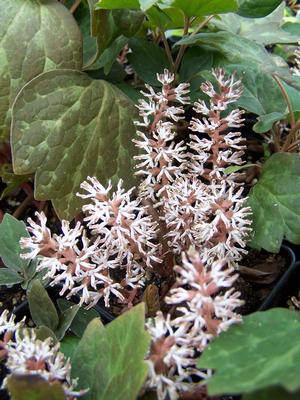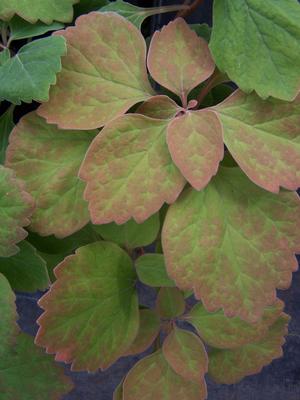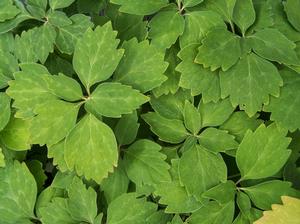
Pachysandra procumbens spring bottle brushes

Allegheny Spurge demonstrating some rusty autumn coloration holding on after a long winter under white poly

Pachysandra procumbens 'Forest Green'
Pachysandra procumbens: The Allegheny Spurge
Pachysandra procumbens: the Allegheny Spurge
Allegheny Spurge is Pachysandra procumbens. Pachysandra, yes. But not the cliched ground-covering Asian pachysandra planted too often in too many landscapes. I became enamored of Allegheny Spurge the first time I espied it at the New York Botanic Garden. Large clumps of it in late autumn had picked up some rusty tones; still the dense clumps were alluring and partly so because of the cool weather color. Whereas many if not most Asian counterparts tend to edge out our native woodlanders on the beauty scale - this being the un-polled aesthetic judgment of most gardeners - Allegheny Spurge countermands this usual assessment.
Allegheny Spurge is a wonderful species with April pinkish-white bottle brush flowers at the soil surface followed by handsome broad-fingered leaves arranged in a whorl at the tops of leaf stems. They are apparently fragrant. I have not personally partaken of this trait in that the soil is usually wet and damp and unpleasant to dry knees at this time of the season! Different forms, discussed below, change color and patterns through the year but tend to be entirely matte-finish medium green in summer. The flat affect is due to the tiniest dense carpet of hairs on the leaves which are barely distinguishable. Autumn brings kaleidoscopic silver and brown leaf mottling especially in sun in the north. The foliage is evergreen on this clumping perennial lasting a full year and then some. Winter will often depress the cushion into a flat mat; this allows for better viewing of the ground-level bottle brush flowers. The new foliage follows and replenishes the thickened carpet. This herbaceous perennial increases with slow spread and never becomes overbearing in the woodland garden.
FOREST GREEN
'Forest Green' is a selected Allegany Spurge with leaf whorls slightly larger than the species. The stems carry the whorl of leaves at the tiptops at a more uniform height creating a more even, level carpet of foliage. This cultivar is subtle in its departure from the straight species and though not often seen has been known for a while.
SPRING GOLD
'Spring Gold' is a sport of 'Forest Green' with a soft golden-infused spring foliage color which gradually becomes greener as the leaves mature. Richard Lighty graciously shared with us a delightful bit of history, “When the Magnolia Society met in the Wilmington/Philadelphia area a few years back (maybe more than a few! Time changes as you age!), they visited Sally's and my Garden, Springwood, in Kennett Square, PA. As everyone was boarding the bus, one of the nurserymen members asked me if he could have a piece of a yellow sport he had seen in a planting of Pacysandra procumbens 'Forest Green' in my little nursery. I said, Oh that. I had seen it and dismissed it as having been the result of my [having been] careless with Roundup. He said "I don't think so! So we went back and quickly dug a piece. I continued to watch it and became convinced that it was a true mutation.”
We, at Quackin' Grass, have been honored by Richard Lighty and Mt. Cuba Center, a remarkable botanic garden in Maryland, to offer 'Spring Gold' and the following cultivar, 'Silver Streak', for the first time...
SILVER STREAK
'Silver Streak' is a lovely selection with a notable difference. All leaves are imbued with beautiful silver mottling and speckling. Foliage typically erupts dark green and remains so during the growing season. It is in the cooler days of autumn when the silver mottling emerges and becomes evident against the green backdrop. The silver-on-green holds steady through the winter. The color in the leaves is light and bright and a real departure from the liver-spotting mottling found in other selections making 'Silver Streak' distinct. First spied at Mt. Cuba Center, found in a planting of unknown origin, 'Silver Streak' came our way from Professor Jon Lehrer with the assent of Jeanne Frett. And we thank Jeanne Frett from Mt. Cuba Center who gave us the green light to offer this silver marvel to you.
PIXIE
'Pixie' is a rare dwarf. According to Tony Avent of Plant Delights Nursery in North Carolina 'Pixie' is one-half to one-third the size of the straight species and form a more refined plant. Typical bottle brush flowers occur at ground level. The foliage then arises to about 4 inches in height and after many years the spread of the plant will be 12 or so inches in diameter. It was originally espied at Holden Arboretum in Ohio. It's still rare in the trade... at the time of this update (March, 2015) we're avidly seeking to add 'Pixie' to our collection.
There exists another exceedingly rare selection to date, 'Eco Treasure Island' introduced by the legendary Don Jacobs of Eco Gardens in Decatur, Georgia. We have no information about this plant - no descriptive narrative; nor do we know of anyone growing this selection. We avidly seek it out.
The native range of Pachysandra procumbens is from West Virginia to Louisiana and east to Florida. And though from haunts more southerly than our own with USDA hardiness to climate zone 9 it is, nevertheless, a doer for us in much of New England. Plants of northern provenance may harbor genetics which insure survive-ability to -25F, zone 4b. Part sun to open shade will suffice though in fertile, moisture retaining organic soils where it is most content it will tolerate even more sun. In these conditions its evergreen display will be a kaleidoscope of pale rusty brown, silvery green and liver spotting that makes this clumping to slow-spreading perennial a spectacular addition to the garden, even in winter. Might you not consider Pachysandra procumbens in your design scheme? Dig in and have fun.
penned by Wayne Paquette, September 2014